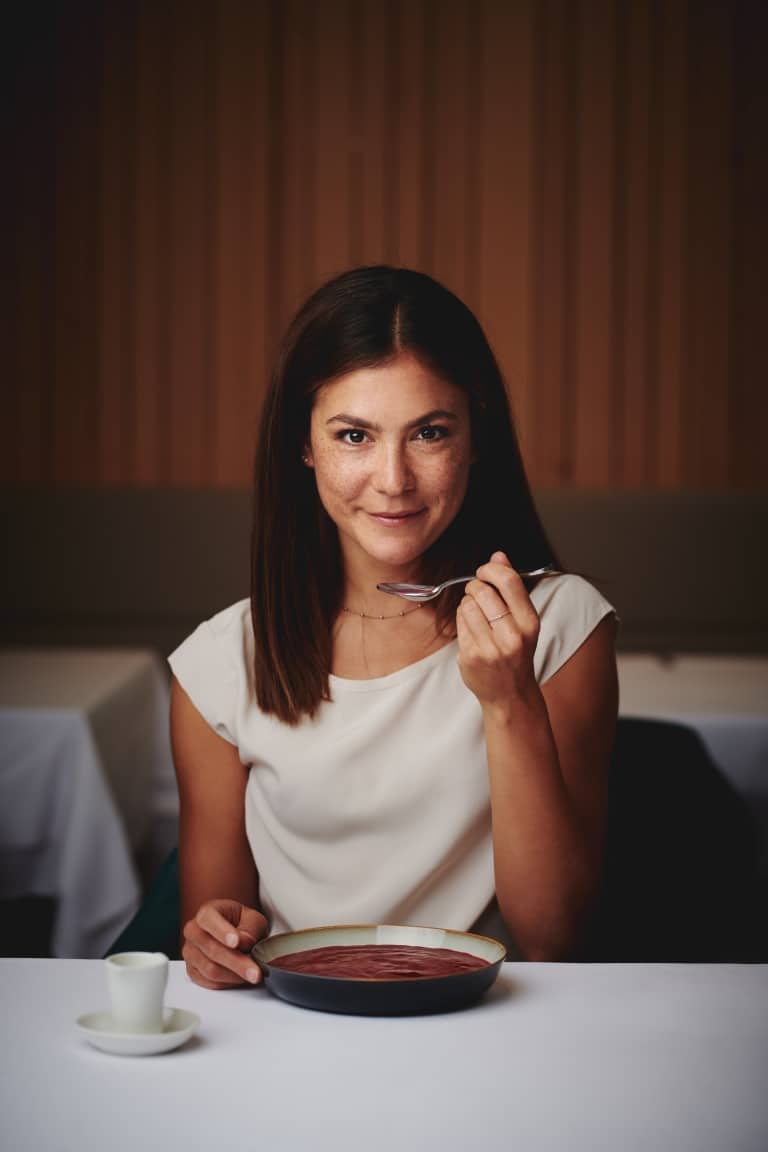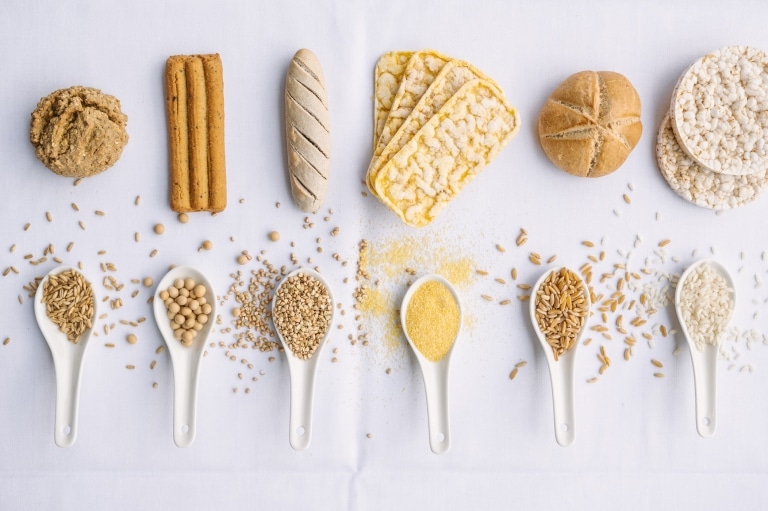5 Busting nutrition myths
There is almost no topic more plagued by misconceptions and half-truths than that of our nutrition. On one hand, this is due to the fact that our nutrition is highly complex and obtaining conclusive research results is often no simple feat. And on the other, every individual is a world in and of themselves, and specific nutritional recommendations are tricky to apply to larger groups of people. Let us lead you through the jungle that is nutrition and clear up five common myths for you. Is skipping dinner healthy? Do carbs make you fat? And is salad always a good choice? Join us on our journey of discovery…
Myth 1: margarine is better than butter because it contains less fat
The reputation of fats and oils has taken a particularly hard hit when it comes to healthy eating. As is often the case, it is worth taking a closer look in order to get to the bottom of this. The fact is that fat, at 9 kilocalories per gram, has the highest energy density of the macronutrients (carbohydrates, protein and fats) and, seen from a purely nutritional point of view, it is indeed ideally suited as a source of energy. However, what is really important here is the specific composition of the fats.
All fats consist of fatty acids that have differing lengths of hydrocarbon chains and that can be either very favorable or, under certain circumstances, less healthy for our organism. While saturated fatty acids are mainly stored as energy reserves in the subcutaneous fat (also known as adipose tissue), unsaturated and polyunsaturated cis fatty acids have a positive impact on our metabolism and generally enhance our overall health. So what does all this have to do with butter and margarine? The major difference between butter and margarine is how they are manufactured. This has a substantial influence on their compositions.
Compared to margarine, butter is relatively simple to produce: milk is churned until the fat separates from the rest of the liquid. Solid globules of butter form, which are then washed and shaped into pats of butter as we know them. And that’s it. This straightforward manufacturing method means that the many beneficial substances in butter are preserved. These include vitamins A, D, E and K2, as well as beta-carotene and the trace elements iodine and selenium. It should also be noted, however, that cold-pressed oils are always preferable to butter, since these contain the polyunsaturated fatty acids that are so crucial to our well-being. These are essential for the body but cannot be produced by the body itself, or only in minuscule quantities if at all. Of the 81 grams of fat that are usually contained in 100 grams of butter, 51 grams are attributed to saturated fatty acids, 21 grams to unsaturated fatty acids and 3 grams to polyunsaturated fatty acids.
While the butyric acid contained in butter has a short-chain, saturated structure and thus exhibits anti-inflammatory properties in the body, the numerous medium-chain fatty acids have an antimicrobial effect and support, among other things, a healthy microbiome in the gut.

Margarine, on the other hand, is an entirely industrial product and is also deemed “imitation butter”. It is made from hydrogenated and non-hydrogenated vegetable and animal fats mixed with water or skimmed milk to produce a high fat content.
In the course of its production, it undergoes many more processing steps than butter, which gradually deprives it of its so-valuable substances – which are then replaced later on. Although the average fat composition of vegetable margarine is around 40 percent saturated, 45 percent unsaturated and 15 percent polyunsaturated fatty acids, butter is always preferable to margarine thanks to its relatively simple and natural manufacturing process. The less processed a food is, the more valuable it is nutrient-wise for our organism. Thanks to the fact that milk fat naturally contains all types of fatty acids, nothing can replace butter. So: there’s no need to deprive yourself of butter, and the best option – as is always the case – is to go for products from organic farming!
Myth 2: no dinner is a good dinner
You’re bound to have come across the myth of skipping dinner and the fact that it is meant to be very helpful in terms of losing weight. But does it really make sense to skip our evening meal entirely? Although skipping dinner once in a while can be very beneficial, it is not necessarily something you should do in the long term. “A better plan is to stick to the saying, ‘Breakfast like a king; lunch like a prince; dinner like a pauper’,” advises Dr. Harald Stossier, our in-house doctor familiar with the Modern Mayr Method. This guarantees that the body receives the nutrients it needs throughout the day and can, in turn, recover well at night, since the digestive system is not overloaded.
Skipping dinner in the evening all the time would go against our natural rhythm. “Instead, have an early dinner so that your body has time to enter into the fantastic mechanism of autophagy overnight,” recommends Dr. Stossier. This leads you very naturally to the mode of interval fasting, in which you abstain from food for a period of at least twelve hours – better yet, up to 16 hours. By doing so, not only are you doing something beneficial for your gut health, but you actually also slow down the aging process.

Myth 3: carbs make you fat
Carbohydrates are shrouded in countless misconceptions and half-truths, including the claim that carbs make you fat. However, in contrast to the source of energy, fats (see above), carbohydrates only provide us with four kilocalories per gram. It’s true that excess carbohydrates are converted into fat in the body (de novo lipogenesis) and stored as adipose tissue. A study headed by scientist Marc K. Hellerstein also showed that an excess consumption of carbohydrates in the context of a varied diet led to a general increase in adipose tissue. However, this did not occur as a result of the conversion of carbohydrates into fat, but rather because it slowed down the burning of fat.
This takes exactly the same line as that represented by Dr. Stossier in his book “Ernährung / Worauf es wirklich ankommt” (Nutrition / what really matters). He says that to burn body fat, first and foremost, the intake of carbohydrates must be reduced, since only then does the body tap into the possibility of using the fat deposited in adipose tissue as a source of energy. The explanation: the consumption of carbohydrates is always associated with the release of the pancreatic hormone insulin, and as long as this mechanism is underway, the burning of fat is inhibited. He explains that this is why it is especially advisable to limit the consumption of carbohydrates when trying to lose weight, which clearly suggests a low carb or even a ketogenic diet.

Myth 4: salad is always a good choice
Salad is known and loved all round – after all, there are so many different varieties of lettuce that can be used: from iceberg lettuce, lamb’s lettuce and arugula to lollo rosso and bionda to radicchio and endives, to name just a few. Many types of lettuce are rich in important nutrients, such as vitamins B1, B2, B6 and C as well as potassium, phosphorus, iron and magnesium. With 15 to 20 kilocalories per 100 grams, the energy content of lettuce is very low, and the fiber contained has a positive effect on the colon and the digestion. With all of these health-promoting properties, surely salad is always a good choice, no? Far from it! Although lettuce generally has an alkaline effect on the organism and thus contributes to a healthy acid-alkaline balance, the time of consumption is crucial.
“After four, at the latest five pm, it’s best to avoid raw fruit and vegetables altogether,” advises VIVAMAYR nutrition expert Kathrin Pötsch, BSc. This is because the long overnight break from digestion can mean that raw vegetables and fruit begin to ferment in the gut, thus fostering the acidic levels in the body. Since our modern-day diet already tends to be generally more acid-based, this can have a negative effect on the acid-alkaline balance. A better option is to eat salad at lunch and reach for steamed vegetables in the evening.
Myth 5: milk is bad for your health
This myth is only true if you have lactose or casein intolerance. Otherwise, milk, especially in its purest form as raw milk, is a very valuable food. It contains several important nutrients, in particular essential amino acids, calcium, phosphorus, potassium and vitamins B and E. What is more, milk, contrary to the dairy products cottage cheese/quark and cheese, has an alkaline effect on the body, which positively influences the .
The only crux is that the quality of milk has not improved over the years. If anything, it has deteriorated. Even when heated very gently, which is necessary for hygiene reasons, changes in the milk protein and the high-quality fats in the milk occur. Good insalivation does allow milk to be better metabolized; however, there is also the fact that many people no longer tolerate milk very well today. The lack of or insufficient presence of the enzyme lactase, which is necessary for the digestion of lactose (or milk sugar), is to blame for this. However, this can also be traced back to a casein intolerance, where those affected cannot or cannot sufficiently digest the milk protein casein. Goat’s and sheep’s milk have a lower percentage of casein than cow’s milk, which can mean that some people are able to better tolerate these products.

However, as long as milk is agreeable to you, there’s nothing to say you shouldn’t consume it. You should take care to consume it in moderation, ensure the milk comes from organic farming and has been processed as little as possible (which means avoiding low-fat milk).
What diet is good for me?
Would you like to know which foods are suitable for your organism – and which are not? Make an appointment at one of our day clinics and allow our experts to test and advise you.
Sources
Dieter Brad, n.d., Die Wahrheit über High Fat Diäten: Mythos Vs. Fakt [The truth about high-fat diets: myth vs. fact], accessed 7.28.2021, 15:55
Hellerstein Marc K., 12.1.2001, No common energy currency: de novo lipogenesis as the road less traveled, accessed 28.7.2021, 16:01
p., n.d., Enterisches Nervensystem [Enteric nervous system], accessed 7.28.2021, 12:32
p., n.d., Förderung der gesunden Ernährung – Energiegehalt [Promoting a healthy diet – energy content], accessed 7.28.2021, 14:11
p., n.d., Margarine, accessed 7.28.2021, 12:52
Reiche Dagmar, 7.7.2017, Salate – Saison rund ums Jahr [Salads – seasonal all year round], accessed 7.28.2021, 14:44
p., n.d., Kaseinunverträglichkeit: Neben Laktose ist Kasein die häufigste Ursache für Beschwerden nach Milch [Casein intolerance: alongside lactose, casein is the most common cause for complaints after consuming milk], accessed 8.12.2021, 16:09
p., n.d., Ziegen- und Schafmilch [Goat’s and sheep’s milk], accessed 8.12.2021, 16:14
Stossier Harald, Stossier Georg, 2018: Moderne Mayr-Medizin & das VIVAMAYR-Prinzip / Du bist, was du verdaust [Modern Mayr Medicine & the VIVAMAYR principle / You are what you digest], 1st edition, Verlagshaus der Ärzte, Vienna
Stossier Harald, Stossier Georg, 2018, Ernährung / Worauf es wirklich ankommt [Nutrition / what really matters], 1st edition, Verlagshaus der Ärzte, Vienna
Tiefenböck Waltraud, 7.23.2014, Milch und Milchprodukte [Milk and dairy products], accessed 7.28.2021, 15:24











